
National Water Center, Eureka Springs, Arkansas

National Water Center, Eureka Springs, AR
Updated: April 2014 Contact: Contact: NWC
Contents ©1999-2014 by National Water Center. All rights reserved worldwide.
WaterWorks Journal, volume 5, MM
(press here to return to full Table of Contents)
healing the waters
The Turbid Tap (Water) Dance
Miriam Ella
Protecting Watersheds Can Save Billions in Water Treatment . .
Trust for Public Land
here
The Task Force to Bring Back the Don . . .
Dalton Shipway
Cuernavaca - "City of Eternal Spring" . . . and Sewage
George Anna Clark
Nuclear Power: Hanging in the Balance in Minnesota
George Cocker
webs of truth
Rosemary Zieroth
Page 26
The Turbid Tap (Water) Dance 1/24/1998
by Miriam Ella
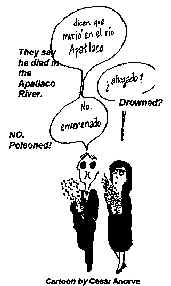 In Milwaukee, nineteen ninety-three, a water bug danced over the graves of children, fifty to one hundred, while thousands more circled the floor, doing the Turbid Tap (Water) Dance. (NAUSEA)
In Milwaukee, nineteen ninety-three, a water bug danced over the graves of children, fifty to one hundred, while thousands more circled the floor, doing the Turbid Tap (Water) Dance. (NAUSEA)
We need another study. Some folks do not agree that the water tap is the source of this morbidity. They can agree, water has fluidity and liquidity. Maybe it's food poisoning. (GASTROINTESTINAL)
Turbidity, say the medical experts in Philadelphia, never, not ever, not once was over the limits as measured from the tap every day from 89 to 93. But, boil your water, folks! On this we can agree. (DIARRHEA)
If the water is so pure out of the tap. Why do rich folks drink store-bought spring water? and why do emergency rooms get overcrowded four days after the turbidity levels rise? (UNKNOWN CAUSES)
It's the Turbid Tap Water Dance ! Do it while you boil your water. It may be the only chance to save our kids till the world wakes up to see that which is not visible, turbidity. (VOMITING)
Pages 27 & 28
Protecting Watersheds Can Save Billions in Water Treatment Costs
Uncontrolled Watershed Development Threatens Drinking Water Supplies and Safety
Watershed protection must be considered part of the overall water supply delivery strategy . . . it's a lot cheaper to prevent pollution than take it out later.
The nearly $140 billion that the U.S. Environmental Protection Agency (EPA) estimates will be ended for drinking water infrastructure over the next two decades can be significantly reduced by modest investment in watershed protection, according to a report issued today by the Trust For Public Land (TPL).
“Watershed protection must be considered part of the overall water supply and delivery strategy,” says TPL President Martin J. Rosen. “The EPA estimated that it will cost billions in concrete and steel to make our water safe to drink. But to rely exclusively on water treatment not only costs more, it undervalues the additional benefits of protecting open space, including habitat preservation, recreational opportunities, and flood control.”
The TPL report, Protecting the Source, underscores alarming declines in both the quality and quantity of America’s drinking water, and traces those declines directly to ill-conceived and uncontrolled development in the watersheds that protect and replenish our drinking water supplies.
The report comes at a critical time. Lands that supply groundwater are being paved over at an alarming rate; aquifers, underground water supplies, are being tapped out and some have already been lost. Ground and surface waters alike are becoming increasingly polluted; hundreds of municipal wells have had to be closed and capped because of ground water contamination. Several cities have had to abandon reservoirs overwhelmed by development’s pollution. “Its a lot cheaper to prevent pollution than to take it out later,” says Jack Hoffbuhr, executive director of the American Water Works Association.
The 1993 Milwaukee cryptosporidium outbreak, which claimed 103 lives, proved that technology cannot infallibly provide safe drinking water. Milwaukee’s water was both filtered and disinfected at the time of the outbreak. (Editor’s Note – It is this incident to which author/poet Miriam Ella refers to in the opening stanza of her poem on the opposite page).
Thomas C. Leslie, executive director of the Consulting Engineers Council of Georgia reports that over a 70 year period, Atlanta and its surrounding communities have had to abandon eight water supplies, all degraded by watershed development. The message, he says, is clear: “If you don’t control the watershed. don’t build a reservoir, because eventually you’ll have to abandon it.”
TPL’s report demonstrates that the preservation of even small amounts of watershed land can significantly reduce contamination and increase quantities of source water. New York City, by investing $1.5 billion to protect and conserve its watershed, will
save up to $8 billion in filtration facility construction costs, plus an additional $300 million annually in operating costs. Former Commissioner of the New York City Department of Environmental Protection Albert Appleton emphasizes, “All filtration does is solve a problem.
Preventing the problem, through watershed protection, is faster, cheaper, and has lots of other benefits. Adding up the costs and benefits, watershed protection was not a difficult decision.”
Sterling Forest, a key portion of the watershed supplying water to 25 percent of the population of New Jersey, is being protected for less than $55 million-with the added benefits of preserving more than 15,00 acres of mature-growth forest for recreation and wildlife.
“Land-use planning is an absolute necessity in watershed management,” says New Jersey Governor Christine Todd Whitman. “Some watershed land simply must not be developed. Its natural value in buffering, storing, filtering and recharging far exceeds whatever commercial development value it may hold.”
National polls consistently show overwhelming support for protecting water quality. Voters in New York and California last year approved referenda that would fund watershed protection, including land acquisition. Localities are also funding long-term protection of watershed: Dade County, Florida, imposes a 3 percent surcharge on water bills; Spokane, Washington, residents pay $15 a year specifically for aquifer protection, and Providence, Rhode Island, collects a special water tax to fund watershed acquisition.
Based on its findings, TPL recommends that:

Local water supply managers incorporate watershed protection in all drinking-water supply management planning;

The states establish permanent sources of funding for watershed land preservation; and,

The EPA make more funding available for watershed land preservation
“Protecting the watershed,” Massachusetts Water Resources Authority Executive Director Doug MacDonald says, “pays both short and long-term dividends. The short-term return is the ability to deliver drinking water that is as palatable as it is potable, at a low cost. And the long-term return is that you repeat the short-term return year after year.”
For more information on this and / or the Trust for Public Land — 116 New Montgomery Street, 4th Floor, San Francisco, CA. Phone: 415-495-4014.
Page 29
here
1
we brag about quitting smoking
have deep conversations about the
amount of beer
at this party or that
and how it sucks
to have an old car
and we pretend
that we don’t know
that she or he today
will bury another child
because it is better to kill
your child
than to see it dying
wouldn’t you do the same
when
every day
your baby’s eyes sink
deeper into the skull
and teeth do not grow
because there are no vitamins
because it is the way life works
it always worked this way
and it’s ok
so don’t you dare to say people are the same
we will be the same
when my words will mean
more than embarrassment
of trying to un-think
forget
slip back to life
2
the flowers need water
like children
i water their former every day
slowly letting their green teeth
and tongues
taste and
drink drink
swim in happiness
and i know the mouths of those
whom i cant reach in
ghana
sudan
and other places with soothing
names
the mouths that look like cracks in
the rocks
like dry scars
i think if i kiss these lips and
bodies
i ll feel the loneliness of sands
you must know
how faces become motionless
when life is sucked away
how eyes loose expression
how bones scream through the
skin
to be heard
to step outside
in an effort to die
because they are not needed
and there is no flesh to support
i can’t give them water
and even if i could
it would not change anything
water
or food
or anything
or everything
in the world
can not resurrect the dying soul
can no let one forgive
god
fate
people
and life itself
they will not forgive life
and they are dead
and we can not do any thing
but look in the eyes of the dying and
see ourselves
just reflections
3
and who knows
might know what god is
they can tell you what
happiness is
they can feel life like we will
never even try
in our world
of plastic-skinned fruit
air-conditioned cars
souls trapped between
newspaper headlines and
restaurant menus
social security numbers
drive-by anger relief
disposable underwear
cholesterol free butter ice-cream
and politically correct
statements
in our world
of neatly packaged american
dreams
(personal size please)
and ten minute guides for lovers
on tape
here where
we
surround ourselves with things
trade our spirits for religions
silence for clouds of empty
words history for entertainment
life for Friday night
and Saturday morning hangover
friends for cocaine . . .
in our world
we don’t know life
we don’t want to know
we don’t want to touch it
because life comes from dirt
and since dirt can be packaged
and reused
we prefer to stay clean
and have it delivered
and i live here
Page 30
The Task Force to Bring Back the Don: Birth of a Citizens Movement
by Dalton Shipway
"Never doubt that a small group f committed citizens can change the world.
Indeed, it's the only thing that ever does". - Margaret Mead
The Task Force to Bring Back the Don was formed in 1989 by the City of Toronto and a group of concerned citizens who believed that the Don River Valley could once again become one of the great natural spaces in the City.
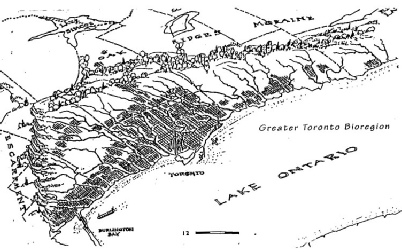
The restoration of the Don has relied partly on the assistance and expertise of scientists, engineers, landscape architects, consultants, planners, and botanists. But first and foremost, the Task orce created a grassroots citizens’ movement that has exploded over the last decade. Working in “bite-sized, citizen-driven projects”. the Task Force and thousands of Torontonians have made enormous strides in restoring the natural biosystems of the Don River and the Valley.
Over ten thousand volunteers have taken part in semi-annual plantings, clean-up days, pond and wetland restoration projects, the creation of wildflower meadows and wildlife corridors, safety and access improvement projects, and community education and involvement programs. Thirty-five thousand trees and shrubs have been planted. The detritus of years of dumping has been largely removed. Regular presentations to schools and outside agencies, guided walking tours, canoe trips down the river and the creation of lively and provocative public art pieces along the river’s edge have made the public increasingly aware that the river runs through us.
We have much to celebrate; there is still a great deal to do before our goal of a clean, green and accessible river valley is attained.
Page 31 & 32
Cuernavaca "City of Eternal Spring" . . . and Sewage
by George Anna Clark
Cuernavaca sits in the foothills of the Chichinautizin moutain range, which runs west and east and separates Cuernavaca from Mexico City on the north. Springs, wells and irriation canals are heavily contaminated with fecal material, resulting in water-borne epidemics such as cholera.
EMPOWERMENT
Empowerment is the foundation of our work, Espacio de Salud, A. C. (ESCA) focuses its endeavors on the end result of powerlessness. Low-income communities have very little control over their daily lives. Low-income persons often don’t expect to have any power over their lives. Therefore, when we work with communities, our greatest priority is in empowerment: We don’t try to convince them that “our” dry toilet is the best, we offer tools so that they realize that they have the ability to analyze and choose (or discover themselves!) whichever solution is needed for their community.
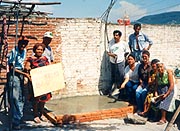 This popular grassroots groups "Ixtelloati" gets together on Sundays to help each other build dry toilets in their homes. They also use them as demonstration models for their neighbors.
This popular grassroots groups "Ixtelloati" gets together on Sundays to help each other build dry toilets in their homes. They also use them as demonstration models for their neighbors.
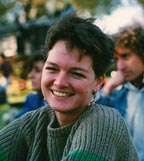
George Anna Clark is the coordinator of Espacio de Salud's environmental program. She is originally from Arkansas and has lived in Cuernavaca, Mexico since 1987.
This sounds very lofty and idealistic, but has its practical side as well... What is the point of wasting our time and resources in training people to build and use dry latrines if a month later the government can convince them to hook up to the sewage system?
DRY TOILETS
The good news is that environmental awareness is increasing! ESAC is presently in great demand by low-income grassroots community groups for our services in environmental education and consultation regarding appropriate technologies.
Although our educational programs include a variety of issues as well as technological options, our assistance is most often requested regarding alternatives to conventional sanitation. The most popular alternative we’ve worked with is the modified Vietnamese double vault latrine. (The modification consist of adding toilet seats to the original seatless design.)
This dry toilet is simple to build using local materials. Similar to a composting toilet, it is easier to maintain and cheaper to build. Because the specially designed toilet separates the urine from the feces, the urine can be easily captured and used as fertilizer or fungicide.
The toilet seats are easily fabricated from used objects such as buckets and funnels cut out of plastic bottles. However, they are also produced by local, independent “micro-businesses’ in southern and central Mexico in a variety of colors and materials. Production has just begun using recycled plastic!!!
For more information regarding ESAC’s work in environment and health issues in the states of Morelos, Mexico, Guerrero, and Oaxaca please write to the following address: ESPACIO DE SALUD, A.C.,Apartado Postal 1-1576,Cuernavaca, Morelos 62001,52(73)18-07-20 (telephone and fax), email: <esac@laneta.apc.org>.
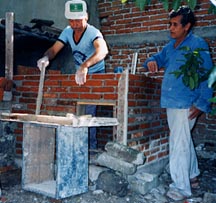
The bricklayer volunteers his time to build dry toilets for his friends and neighbors. They assist by mixing the cement and providing the beer!
BAD AS WELL AS GOOD NEWS
Mexico has suffered in the last 25 years an ever worsening spiral of environmental, economic and political crises which seem to deepen at every turn. On the other hand, ESAC’s staff is blessed to be working with many groups of low-income, marginalized women (as well as a few men) who are deeply committed to protect the environment and the health and well-being of their communities.
Page 33, 34 & 35
Nuclear Power: Hanging in the Balance in Minnesota
by George Crocker
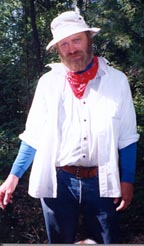
In 1994, Northern States Power Co. (NSP) had to make a nuclear waste deal in the Minnesota Legislature. The resulting law had three primary parts: it increased high-level nuclear waste storage capacity for NSP’s Prairie Island Nuclear Power Plant (PI) by 680 waste fuel assemblies; it set a limit on the amount of high-level nuclear waste that PI can produce; and, It mandated renewable energy development in several ways. But the heart of the deal is that unless a federally authorized program is accepting PI high-level nuclear waste when the storage capacity limit is reached, NSP will shut down the twin 530 MW PI reactors.
Legislators intended the law to provide PI with enough storage capacity to last until 2002. As soon as the law passed, though, NSP extended the storage capacity life to 2004 by leaving fuel in the core longer. This makes the waste more difficult to manage for the next 240,000 years, and never mind that throughout the decision-making process, NSP claimed that higher fuel burn-up was not possible. Through 1997, NSP tried and failed to get the legislature to get rid of the storage capacity limit, and NSP knew it would fail again in 1998. NSP switched tactics and sought permission from the Minnesota Public Utilities Commission (MPUC) to cram 195 additional waste assemblies into the PI storage pool. This would extend PI reactor operations until 2007. The North American Water Office (NAWO) opposed NSP's proposal before MPUC to no avail, and is challenging MPUC authority to supercede the limit set by law in 1994 in the Minnesota Court of Appeals. We like our chances.
Meanwhile, ever since 1994, NSP has led the nuclear industry's irresponsible efforts to get a high-level nuclear waste dump in a parking lot next to Yucca Mountain in Nevada, and to establish a private dump somewhere in Indian Country. NSP wanted a private dump on Mescalero Apache Reservation in New Mexico, and when that failed, now is seeking a private dump on the Skull Valley Goshute Reservation in Utah. NAWO and its many allies continue working diligently to stop these ill advised projects, and fortunately, NSP has so far had no more success with these various "Mobile Chernobyl" proposals than it had in the Minnesota Legislature.
The nuclear waste management strategies sponsored by the nuclear industry all rely on putting waste into thousands of dry storage casks. The industry pretends it knows how to unload and maintain casks after a storage period, but it doesn't. The industry's underlying assumption is that essential cask unloading and maintenance procedures are simply the reverse of loading procedures. But they aren't. So every cask that gets loaded may end up releasing its deadly radionucloids into the environment as a result of thermal shock, liquid metal embattlement, metal creep, or any of a number of other ill-understood degradation modes that are not accounted for. NAWO is attempting to address this troubling situation through a petition to the Nuclear Regulatory Commission (NRC), asking it to establish cask management rules that account for these degradation modes. The NRC was forced to open a rule-making docket, but the issues remain unresolved.
At any rate, no dump outside of Minnesota is accepting PI high-level waste. It is not likely such a dump will exist by 2004, when authorized PI storage capacity is full, assuming NAWO prevails in state court this fall against the PUC. Even if NAWO does not prevail, NSP will be hard pressed to have a dump outside of Minnesota for PI waste by 2007. In other words, if the forces of Truth and Justice in Minnesota can, for the next four years, prevent NSP from changing the law, we will force PI to close. And the door to a safer energy future based on the efficient use of locally available renewable energy will be knocked open a bit further. Our hope is that we can shut these reactors off before nuclear steam generators explode, or some other human or mechanical failure results in catastrophic radiation releases.

Nuclear power, however, is not the only threat to an efficient and renewable energy future.
NSP and other Mid-west electric utilities want to broker an additional 5,000 MW of Manitoba Hydro electricity from new dams along the Churchill Nelson River system into U.S. markets. If we allow this to happen, Manitoba hydro-power will be priced to undercut and prevent utility-scale conservation and renewable energy development throughout the region. Worse, massive additional acreage of boreal forest, the ancestral homeland of the Cree, will be inundated. Flooding on top of the Canadian granite shield mobilizes mercury, which concentrates in the fish and poisons the people. As the forests, bogs and wetlands get flooded and the organic material dies and rots, methane and other greenhouse gasses get released at a rate that rivals fossil fuel combustion on a per kilowatt-hour basis. This is like cutting the lungs out of the Northern Hemisphere.
For better or worse, new large power lines are needed to transmit this imported hydro-power into the U.S. People in East-Central Minnesota and West-Central Wisconsin have already organized to defeat the first of these power line projects, the Chisago Project, which NSP wanted to cross the Wild and Scenic St. Croix River at Taylor's Falls, and then go east and south. Putting the breaks on the Chisago Project only opened the door for Minnesota Power Co. to resurrect the Arrowhead-Arpin Line, which would transmit the same Manitoba hydro-power from Duluth down to Wausau, Wisconsin, and into the Milwaukee/Chicago area. So now, people are organizing ferociously against the Arrowhead-Arpin Line. Already, four counties and the Lac Court Oreilles Tribe have passed resolutions against this power line.
Central to the organizing strategy against these power lines is the fact that they are not needed for the "greater public good." They are only needed to transmit bulk power to distant load centers for the aggrandizement of private corporate interests. By what right do these corporations get to exercise the power of eminent domain? On the other hand, if landowners all along the line route must be made business partners, and compensated according to how many kilowatt hours passed through their property on an annual basis, the delivered price of electricity won't be so cheap. The captains of industry who covet cheap power in de-regulated energy markets may then decide to look again at safer, cleaner, more equitable energy options.
Concurrently, transmission constraints limit the amount of renewable energy from wind capacity mandated by the 1994 law that can go to market. If landowners along these line routes become business partners in bringing that wind energy to market, we may set precedence regarding how electricity is brought equitably to market in a restructured electric utility environment. We shall see about ideology, pragmatism, and how crazy people are.
In short, our energy future is still up for grabs. If enough of us learn to understand our stake in public electric utility decision-making proceedings, and organize to defend our interests, our children may still have a fighting chance. If we help them learn how to fight!
George Crocker co-founded the North American Water Office in 1982 with his wife, Lea Foushee, to reduce pollution and environmental racism caused by large nuclear, fossil fuel and hydro power plants. Through public education, organizing and intervention, they promote the transition to energy management based on the efficient use of local renewable energy resources. Since 1988, this work has been primarily focused on Northern States Power Co.'s nuclear operations on Prairie Island. Prior to founding the North American Water Office, George worked with farmers across West-Central Minnesota and North Dakota who were fighting against the huge direct-current power line stretching east from the Coal Creek Station in North Dakota to the Twin Cities. Between 1973 and 1978, he worked in the food co-op movement. He worked in the Draft Resistance Movement during the Vietnam War, and served 18 months in federal prison for refusing military induction. George is on the Steering Committee of the Prairie Island Coalition, is a board member for Minnesotan's For An Energy Efficient Economy, and helps provide direction for the Sustainable Energy for Economic Development (SEED) Campaign. He is also on the Steering Committee for the Nuclear Waste Citizens Coalition, which coordinates the national movement for responsible nuclear waste management. George and Lea live in an off-peak solar powered home, demonstrating that people can manage their energy needs more responsibly. They have two daughters, ages 21 and 19, and a seven year old son.
Page 35
webs of truth
by Rosemary Zieroth
feel
flow
i feel
as an ethereal spirit in the woods
part of it
around me teems the spirit
around me the secrets spin webs of truth
i walk through
i will not look
i can not see
but feel, what is it i feel
in the woods
but truth and my own soul secrets
secrets because
we do not listen with our soul
to the rain sliding over the leaves secrets
secrets
listen with your soul to
the rain sliding over the leaves
secrets
Nature is the sanctuary of all
let it be
Rosemary Zieroth resigned from her technical writing career ten years ago to enter semi-retirement and found herself writing poetry. The poems in this publication are from a group of poems she calls "The Earth and Me." Ms Zieroth has written for local newspapers in Carroll County (Arkansas). She is currently enjoying her nine grandchildren spread from Connecticut to Arkansas.
Go To: celebrating water

Scroll down to see individual titles in this section.